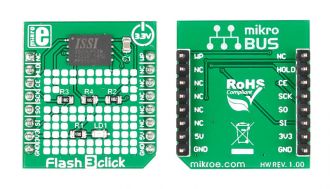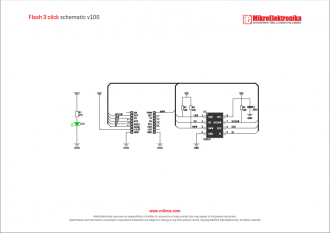
We strongly encourage users to use Package manager for sharing their code on Libstock website, because it boosts your efficiency and leaves the end user with no room for error. [more info]

Rating:
Author: MIKROE
Last Updated: 2019-05-03
Package Version: 1.0.0.1
mikroSDK Library: 1.0.0.0
Category: FLASH
Downloaded: 5624 times
Not followed.
License: MIT license
Flash 3 click is a mikroBUS add-on board for adding more Flash Memory to your target board microcontroller. It carries an ISSI IS25LP128 IC with 128 Mbit capacity.
Do you want to subscribe in order to receive notifications regarding "Flash 3 click" changes.
Do you want to unsubscribe in order to stop receiving notifications regarding "Flash 3 click" changes.
Do you want to report abuse regarding "Flash 3 click".

Library Description
The library covers all the necessary functions that enables the usage of the Flash 3 click board. It offer a choice for writing and reading into and from memory array, also user can access status, and function register and use diferent erase functions. For additional functionality user can check the state of HLD, CE and PW pins.
Key functions:
void flash3_normalRead( uint32_t addr, uint8_t* buff, uint32_t cnt ) - Function is used to read memory contents at a maximum frequency of 50MHz.void flash3_write( uint32_t addr, uint8_t *buff, uint32_t cnt ) - Function is used to write data into Flash 3 device.void flash3_fastRead( uint32_t addr, uint8_t* buff, uint32_t cnt ) - Function is used to read memory contents at a maximum frequency of 133MHz.Examples description
The application is composed of the three sections :
void applicationTask( )
{
mikrobus_logWrite( "", _LOG_LINE );
mikrobus_logWrite( "____________________", _LOG_LINE );
mikrobus_logWrite( "Begin demonstration!", _LOG_LINE );
mikrobus_logWrite( "", _LOG_LINE );
mikrobus_logWrite( "Writing : ", _LOG_TEXT );
mikrobus_logWrite( valIn, _LOG_LINE );
flash3_write( 0x000000, &valIn[ 0 ], 6 );
Delay_ms( 100 );
mikrobus_logWrite( "------------------", _LOG_LINE );
mikrobus_logWrite( "Reading : ", _LOG_TEXT );
flash3_normalRead( 0x000000, &valOut[ 0 ], 6 );
mikrobus_logWrite( valOut, _LOG_LINE );
Delay_ms( 100 );
mikrobus_logWrite( "------------------", _LOG_LINE );
mikrobus_logWrite( "Erasing...", _LOG_LINE );
flash3_sectorErase( 0x000000 );
Delay_ms( 300 );
mikrobus_logWrite( "Erased!", _LOG_LINE );
Delay_ms( 100 );
mikrobus_logWrite( "------------------", _LOG_LINE );
mikrobus_logWrite( "Reading : ", _LOG_TEXT );
flash3_fastRead( 0x000000, &valOut[ 0 ], 6 );
mikrobus_logWrite( valOut, _LOG_LINE );
Delay_ms( 100 );
mikrobus_logWrite( "------------------", _LOG_LINE );
mikrobus_logWrite( "Demonstration over!", _LOG_LINE );
mikrobus_logWrite( "___________________", _LOG_LINE );
mikrobus_logWrite( "", _LOG_LINE );
Delay_ms( 5000 );
}
Other mikroE Libraries used in the example:
SPIUARTAdditional notes and informations
Depending on the development board you are using, you may need USB UART click, USB UART 2 click or RS232 click to connect to your PC, for development systems with no UART to USB interface available on the board. The terminal available in all MikroElektronika compilers, or any other terminal application of your choice, can be used to read the message.
